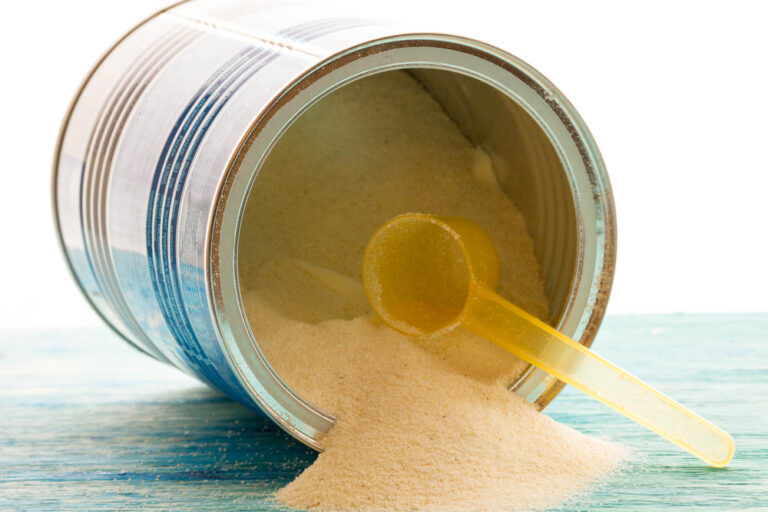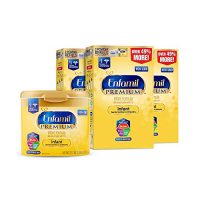Editor’s Note
As of May 2022, many formulas have become increasingly difficult to find. Please read our article, What To Do If You Can’t Find Baby Formula, for more information regarding the formula shortage.
For babies who need a dairy-free source of nutrition, soy infant formula can be a life-saving option. It’s also available for families who follow vegan, halal, or kosher diets. Furthermore, soy can be a gentle, plant-based option for sensitive tummies as it can be easier to digest. Many babies suffer from fussiness and gas pain, and a soy alternative can help.
There are a few medical conditions for which soy infant formula is recommended. Infants born with galactosemia cannot process the naturally occurring sugar in cow’s milk. In the U.S, all infants are tested for this condition at birth. Consuming such formula would be life-threatening. During bouts of diarrhea due to a viral or bacterial infection, infants can become temporarily lactose intolerant. Soy formula is a good, temporary alternative that can provide nutrition while helping to bind the stools. However, for most infants, the American Academy of Pediatrics does not recommend the routine use of soy infant formulas (source). They are also inappropriate to give infants who have a cow’s milk protein allergy.
The best soy formula on the market is Earth’s Best Non-GMO Plant Based Infant Formula.
Best Soy Formula for Your Baby
Earth’s Best Plant Based Baby Formula uses non-GMO soy with along with organic ingredients. Similac Soy Isomil Formula adds non-GMO sugar and corn syrup instead.
Earth’s Best Plant-Based Powder Formula with Iron
The Earth’s Best Plant-Based Powder Formula with Iron is the only organic and non-GMO soy option. Therefore, it automatically stands apart from other soy formulas because it offers the healthiest ingredients.
However, this formula is not perfect. We prefer not to see corn syrup or palm oil in baby formula. While these are commonly used ingredients, a different source of carbohydrates and fat would be better.
That being said, we love Earth’s Best because they do use the finest organic and non-GMO ingredients, making this product unique. Babies need the energy that carbohydrates provide, so at least it’s high-quality corn syrup.
Ingredients
The list of ingredients consists of carbohydrates first, protein second, followed by fats, and all of the other nutrients. As noted earlier, corn syrup solids are the main source of calories.
Unlike other options, the whole soy protein is included in this formula, not an isolate. Soy protein isolate is easier to digest, but chemicals such as hexane may be used in the manufacturing process (source). It may also strip the soybean of some important nutrients. With Earth’s Best your baby gets all of the available nutrients from the soybeans. While this may make it a bit more difficult for some babies to digest, it is a healthier option.
The fats included in this formula are organic palm, soy, coconut, safflower and sunflower oils. Although palm oil helps to keep a baby’s stools soft, it reduces calcium absorption. Hopefully, the company will remove or reduce the palm oil in its products in the near future.
In addition, this formula provides ARA and DHA for immunity and brain health as well as an extensive list of vitamins and minerals. This is all to keep your baby healthy. However, the formula does include organic soy lecithin as an emulsifier and a source of omega 3 and 6 fatty acids. Soy lecithin has a lot of benefits, but hexane may be used in the extraction process.
Final Thoughts
Earth’s Best has recently changed their plant-based formula to include non-GMO soy. All of the other ingredients, however, are organic. Since most soybeans in the U.S. are genetically modified, this shows the commitment of this company to provide the best available ingredients for babies. The addition of DHA and ARA are also a plus.
While this formula is still guilty of using corn syrup, all companies who manufacture soy formula use it because that’s what the FDA approves. Despite this, Earth’s Best is still our favorite option,.
Many babies may experience hard poop, and frequently spit-up while taking soy formula. Others may dislike its taste, but this can be true with any soy formula.
Enfamil ProSobee Infant Formula
The Enfamil ProSobee Infant Formula has been a popular soy formula brand for years. However, similar to others on the market, its first ingredient and primary carbohydrate is corn syrup. Even worse, this formula has palm and soy oils for the sources of fat. It does, however include DHA and ARA to support brain development.
We would love to see Enfamil add some of the “designer ingredients” used in their cow’s milk-based infant formulas such as Lactoferrin or MFGM. Unfortunately, babies who drink plant-based formulas don’t have this option.
Let’s take a look at the ingredients, and see what makes this powder unique.
Ingredients
Most people would expect a soy formula to actually include that as its first ingredient. But no, the company prioritizes the carbohydrates and fats. Perhaps this is an attempt to mimic breastmilk in the proportion of carbohydrates. Breastmilk has 7% carbs, 3.8% fats, 1% protein, then vitamins and minerals (source).
Like most soy formulas, this one starts with 54 percent corn syrup. That means your baby is getting a form of sugar called glucose instead of the lactose found in breastmilk or cow’s milk.
26% of this infant formula is a mixture of vegetable oils, including palm olein, coconut, soy, and high oleic sunflower oil. As we mentioned above, palm oil can reduce the amount of calcium that babies absorb. Dietary soy oil has also been linked to obesity, diabetes, and some neurological disorders (source). Although the manufacturer may add this oil for consistency, it is not an ideal choice.
Soy protein isolate is the third ingredient in this formula. Keep in mind that this form of soy is controversial due to the chemicals used during processing. There is also the question of potential estrogen effects from soy ingestion. Research results have been inconclusive, and, for the majority of infants, soy formulas are generally considered to be safe. It is recommended, however, that infants born with a thyroid problem should avoid soy formula (source)..
Enfamil ProSobee also includes ARA and DHA, healthy fats added to improve brain and eye health. The remaining ingredients are the vitamins and minerals that babies need to stay healthy.
Final Thoughts
If soy is the right option for your baby because of previously stated reasons, Enfamil ProSobee is a solid choice. However, we would prefer that it did not contain corn syrup, and had a better blend of fats. Aside form the corn syrup solids, there is no additional sugar in this infant formula which is definitely a benefit.
More “designer ingredients” would be ideal, but, because of limited demand for soy formulas, most companies skip adding them. Also, such ingredients may be cow milk-based which defeats the purpose of a plant-based option.
Similac Soy Isomil
If you prefer a soy formula with a bit less corn syrup, check out the Similac Soy Isomil. While its first ingredient is still corn syrup, it’s not as much. It also contains more protein than fat which is closer to breastmilk. Unlike Enfamil’s soy formula, this option includes one of Similac’s patented ingredients: OptiGro. This is their blend of DHA, lutein, and vitamin E, their “brain power” combo.
The company markets Isomil as vegetarian-friendly, and soothing for sensitive tummies. This gentle formula, is meant for babies with temporary lactose intolerance or galactosemia (a disorder that affects how the body processes the sugar galactose). Because of the soy protein isolate, it’s also easy to digest, making it great for infants suffering from fussiness and gassiness.
Ingredients
As previously stated, the first ingredient is corn syrup, followed by 14% soy protein isolate, and 11% fats. This is the same order of these nutrients in found breastmilk. Despite less corn syrup, there is another 10% of sugar added, making the total sugar content equivalent to other soy formulas on the market. Yes, corn syrup is a safe source of energy, but safe doesn’t necessarily mean healthy.
Similac Isomil is free of controversial palm oil, instead using safflower, soy, and coconut oils. While we don’t love the soy due to processing concerns, it is logical for it to be included in a soy infant formula. However, the manufacturer could have simply increased the amount of the other two oils, and completely avoided this ingredient.
One benefit of Similac’s Isomil is the addition of the prebiotic fructooligosaccharides (or FOS for short). This ingredient is a sweetener, but also a beneficial source of soluble fiber. It is food for healthy gut bacteria, and can help reduce blood sugar levels.
Similar to its competitors, this soy formula contains DHA and ARA for brain health and immunity, and FDA recommended amounts of vitamins and minerals.
Final Thoughts
Although vitamins and minerals are important, the main formula ingredients take priority. Although Similac Isomil has a little less corn syrup than Enfamil’s ProSobee, it still has a ton of sugar. Less sugar would be better in something that is your baby’s only source of nutrition for the first formative months of life.
Also, despite marketing to vegetarians, this formula is not labelled as non-GMO. This means that the soybeans used for the protein isolate are most likely genetically modified (source). Some of the other ingredients may be as well. On a positive note, it lacks controversial palm oil.
Mama Bear Powder Infant Formula with Iron
The Mama Bear Powder Infant Formula with Iron offers a soy formula option without an expensive price tag. This Amazon version is comparable to Similac Isomil and Enfamil ProSobee. Its ratio of carbohydrates, proteins, and fats resembles the nutritional profile of Isomil, but without the additional sugar. Unlike the other brands, however, the exact percentages of these ingredients is not indicated on the label.
The company touts that its product will cause less gassiness and fussiness while providing complete nutrition. The company also adds extra ingredients designed to improve babies’ health. As you have probably have guessed, the first ingredient is corn syrup.
Let’s take a closer look at the list of ingredients.
Ingredients
Like breastmilk, this soy formula has a mostly carbohydrates (corn syrup), followed by protein, fats, and the remaining ingredients. The protein source is soy protein isolate. As for fats, this formula includes a blend of palm olein, soy, coconut, safflower, and sunflower oils.
Again, palm oil and soy oil are controversial at best, and it would be nice if all formula companies would stop using them. The company adds DHA, ARA, and lutein for brain, eye, and immune system development (source). The addition of prebiotic fructooligosaccharide also helps to improve gut health.
All of the vitamins and minerals a baby needs are included in the formula. What isn’t in this formula is added sugar, beyond the use of corn syrup, of course.
Final Thoughts
Mama Bear soy formula is a high quality option comparable to other products on the market. It lacks the extra sugar that Similac adds to Isomil. One great thing we love about this formula is its lower cost. However, it is not non-GMO or organic, meaning the quality of the ingredients is not equivalent to those in Earth’s Best soy formula.
For those on a budget, this is an excellent choice, with complete nutrition for babies. It’s not perfect, though, as it contains palm oil.
Soy Formulas Compared
The table below compares only the recommended products on this page. A low or high Price means it is low or high compared to the other products listed. The Popularity Score reflects how often readers click on and buy the product. The Quality Score is our assessment of the overall performance and satisfaction with the product compared to others in the table.
| Similac Soy Isomil | 8.9 | 9.4 | 151.72 |
| Enfamil ProSobee Infant Formula | 9.9 | 9.2 | 38.88 |
| Earth's Best Plant-Based Powder Formula with Iron | 3.9 | 8.6 | - |
| Mama Bear Powder Infant Formula with Iron | 6.7 | 8.6 | - |
Buying Criteria
When You Should Pick Soy Formula
Soy may be the right choice for babies who seem sensitive to cow’s milk protein or have congenital galactosemia. Because other options are limited, it is appropriate for infants of parents who follow a vegan, vegetarian, kosher or halal diet.
However, if your baby is simply gassy and fussy, they may not need soy formula.
Keep in mind that cow’s milk has two protein components: whey and casein. Whey is easier to digest, and is less likely to trigger an allergic reaction than casein which actually forms “clumps” in the stomach. Most regular infant formulas contain both whey and casein. Cow’s milk proteins are larger that breastmilk proteins because they are intended for baby cows. In order for infants with a cow’s milk protein allergy to tolerate them, companies hydrolyze these proteins for use in hypoallergenic infant formulas. Because these specialty formulas are quite expensive, some parents may consider trying a soy infant formula. However, because 50 percent of these infants are also are allergic to soy, they are not recommended (source).
Another difference is that cow’s milk has 20 percent whey and 80 percent casein, while breastmilk has 60 percent whey and only 40 percent casein. Your baby may not actually have a milk allergy if they are just fussy or gassy. Instead the issue may be the large amount of casein. One way to combat this is to try formulas with more whey than casein, or with partially hydrolyzed proteins (that is, broken down into more manageable pieces to help babies with digestion).
Soy is so controversial that we highly suggest talking to your doctor or a nutritionist before switching. With so many available formula options, there are many others to try first.
Symptoms of Cow’s Milk Protein Allergy in Infants
Before changing infant formulas, look for the following symptoms:
- Dry, eczema-like flaky patches
- Hives or raised red spots
- Vomiting after feedings
- Either swollen lips or tongue
- Streaks of blood in stools
- Very fussy and irritable after feedings
- Poor weight gain
Alternative to Soy Formula
Soy formula is not the only option for gassy and fussy babies. A formula with partially hydrolyzed cow’s milk protein or a higher whey content may be more effective. Such formulas are often labelled “sensitive or comfort.” There is a newer option with A2 Milk which is thought to be easier to digest. We recommend trying Enfamil Reguline before switching to soy because of its partially hydrolyzed proteins, and higher whey content for easy digestion.
Most major formula companies offer different options for babies who are allergic to cow milk such as Enfamil’s Nutramigen or Similac Alimentum.
Another formula that’s completely plant-based is Else Plant-Based toddler formula. It’s organic, non-GMO, and dairy, soy, and even corn-syrup-free! The protein sources are buckwheat and almond butter. The only questionable ingredient is maltodextrin, a corn-based thickener. However, this product is specifically for toddlers, and does not yet have the FDA approval for use under 12 months old.
For infants with very severe allergies who cannot tolerate hydrolyzed infant formula, there is amino acid baby formulas. However, it also contains corn syrup. Before changing to this type of elemental formula, you should speak to a doctor.
Mind you, all baby formulas have at least one undesirable ingredient. Decide which are most important to you, and always review the label before choosing a formula for your baby. Ultimately, whichever formula your baby can and will drink is the best choice. All products made in the U.S. are regulated by the FDA for safety.
Problems With Soy Formula
One of the main concerns about soy formula is that most contain genetically modified ingredients. Corn and soy are two of the most frequently genetically modified crops. It is done to increase the resistance to pests, and alter their nutritional profile (source). Also, the discussion about potential health effects from the use of soy protein or oil is ongoing. For these reasons, soy infant formula should be considered a last resort choice.
In addition, most of these formulas contain large amounts of corn syrup in place of the lactose used in cow’s milk-based formulas. Some even have additional sugars. Research shows that early introduction to “sweet tastes” influences the developing infant palate (source). It is best to avoid added sugars in the diet wherever possible.
Finally, soy formula has not been proven to reduce colic or allergies. In fact, infants who are allergic to cow’s milk often are allergic to soy as well. Most soy formula is labeled in a way that indicates it’s for gassy, fussy babies. This is a marketing tactic and inappropriate labeling. Soy should only be the first formula choice in cases of galactosemia, or infants of families who avoid animal products.
FAQs – Soy Formula
Which soy formula is closest to breastmilk?
No soy formula is closest to breast milk because the ingredients are completely different. What can be similar is the ratio of carbs, protein, fats, and nutrients. Soy milk is very different from breastmilk, and the two are not comparable. Breastmilk is the best choice for babies, but formula is a viable option for those who cannot breastfeed.
Does soy formula taste different from a milk-based formula?
Most definitely! A baby who has tried a milk-based formula will have a difficult time adjusting to the strong and odd taste of soy. It’s one of the reasons companies add so much corn syrup, to counteract the taste. Similac Isomil, with a second added sugar, tends to be the better tasting option.
Should I get my toddler soy toddler formula if they had soy formula as babies?
While it may seem reasonable to transition to a soy toddler formula, once your baby is a year old, it is typically not medicaly necessary. Most toddlers are able to tolerate whole cow’s milk. The AAP recommends soy milk for toddlers who who follow plant-based diets, or who still show signs of a milk allergy (source). They discourage giving toddler formulas. Although there are a wide range of non-dairy options to consider, many do not have a high enough fat content. Fats are important for the developing brain and nerve connections at this age, so adequate dietary fat intake is key. We, therefore, recommend speaking to your doctor or a nutritionist before trying an alternative milk.
Will soy formula cause constipation in my baby?
Soy formula can cause hard stools in babies. In fact, it is often recommended to help reduce diarrhea related to illnesses. The only way to know if your baby will experience this side effect is to try it.
Can I use soy formula for a preemie?
No. Soy formula is not recommended for premature babies. Pre-term infants typically need a higher calorie formula to promote weight gain and growth. All preemie formulas are made with cow’s milk.
Why isn’t Gerber Plant-Based Protein formula on this list?
We aren’t fans of most soy formulas because they contain corn syrup instead of lactose as the primary ingredient and source of carbohydrates. Gerber adds an even more questionable ingredient: corn maltodextrin. When ingested, this starch can cause blood sugar increases, even higher than plain sugar. This is why it should never be the first ingredient in a baby formula.
To make matters even worse, the Gerber soy formula has an additional sugar and palm oil. We aren’t comfortable giving a baby a formula with three very questionable ingredients. Since there is no indication on the product label, it is likely that Gerber’s soy formula includes GMOs as well.










